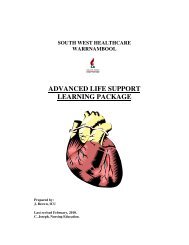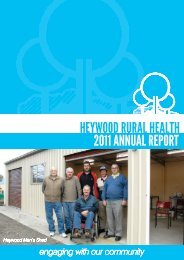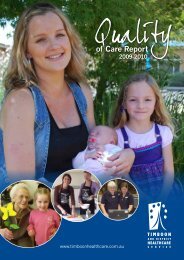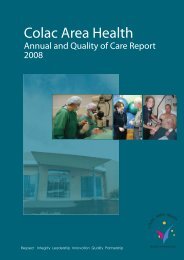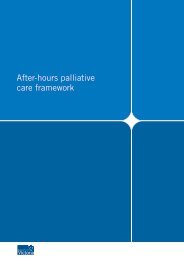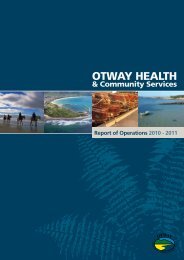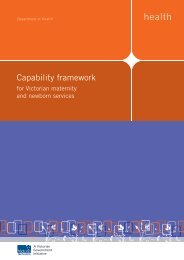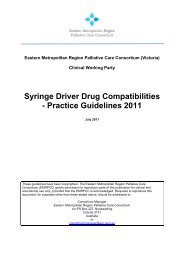Download - South West Alliance of Rural Health
Download - South West Alliance of Rural Health
Download - South West Alliance of Rural Health
You also want an ePaper? Increase the reach of your titles
YUMPU automatically turns print PDFs into web optimized ePapers that Google loves.
Safe Use Of<br />
Blood And Blood<br />
Products<br />
Timboon and District<br />
<strong>Health</strong>care Service is<br />
aware <strong>of</strong> the importance<br />
to patients and staff <strong>of</strong> the<br />
safe practices in the use <strong>of</strong><br />
blood and blood products.<br />
We are aware that the evidence suggests<br />
that major threats to patient safety from<br />
transfusion relate to errors in decision<br />
making and in the way blood products<br />
are administered, rather than to inherent<br />
problems in the actual blood products.<br />
Blood Monitoring<br />
2010-2011 – 20 Units <strong>of</strong> blood were<br />
transferred<br />
Actions taken by staff to<br />
ensure safe use <strong>of</strong> blood<br />
and blood products<br />
• The adoption <strong>of</strong> National<br />
Guidelines for the use <strong>of</strong><br />
blood components.<br />
• The development<br />
<strong>of</strong> a Transfusion<br />
Administration Checklist.<br />
• 100% <strong>of</strong> nursing staff<br />
completed nationally<br />
endorsed training in<br />
e-learning on blood<br />
safety.<br />
• 100% <strong>of</strong> nursing staff<br />
completed Timboon<br />
and District <strong>Health</strong>care<br />
Service’s competency<br />
assessment for safe<br />
blood transfusions.<br />
• The continued documentation<br />
and auditing <strong>of</strong> the use <strong>of</strong> blood<br />
products.<br />
Adopted flow chart for safe use <strong>of</strong> blood and blood products<br />
LIMITED ADVERSE<br />
OCCURRENCE<br />
SCREENING –<br />
MONITORING<br />
CLINICAL PRACTICE<br />
Limited Adverse<br />
Occurrence Screening<br />
(LAOS) is a system used<br />
to identify critical incidents<br />
that may occur in hospital.<br />
Medical records are reviewed by general<br />
practitioners from across the state to<br />
find out if anything could have been<br />
done better. Twelve small rural hospitals<br />
throughout the Otway Division <strong>of</strong> General<br />
Practice participate in the program.<br />
There is a carefully managed process<br />
to ensure medical records are handled<br />
in a secure way to maintain privacy<br />
and confidentiality. The main purpose<br />
<strong>of</strong> the reviews is to provide feedback,<br />
supervision and educational opportunities<br />
for general practitioners and to raise best<br />
practice awareness. The LAOS reference<br />
panel is scheduled to meet four times<br />
per year and reviews files that contain<br />
adverse events or learning opportunities.<br />
An ‘Adverse Event’ is something that<br />
has “resulted in temporary or permanent<br />
disability, hospitalisation, including<br />
increased length <strong>of</strong> stay and or financial<br />
loss to the patient, and the event was<br />
caused by healthcare management (either<br />
at an individual or systems level) rather<br />
than the underlying disease process”.<br />
A ‘Learning Opportunity or Educational<br />
Opportunity’ is an incident or issue that all<br />
General Practitioners can learn from.<br />
Initially the file is sent to the treating<br />
General Practitioner for their comments<br />
then the reference panel makes a<br />
recommendation after a prolonged<br />
discussion and then all General<br />
Practitioners within the Otway Division<br />
<strong>of</strong> General Practice receive the<br />
recommendation report as part <strong>of</strong> a local<br />
quality forum which is held twice yearly.<br />
This is the forum where the Timboon<br />
and District <strong>Health</strong>care Service invites<br />
their admitting General Practitioners to a<br />
meeting to discuss the latest distributed<br />
LAOS recommendations, how these<br />
recommendations have any effect on<br />
patient care at that particular hospital and<br />
how the General Practitioners can work<br />
together to ensure quality care.<br />
Compliance with legislative<br />
and departmental policy<br />
requirements, including<br />
hospital accreditation<br />
Accreditation<br />
Timboon and District <strong>Health</strong>care Service<br />
participates in an accreditation process<br />
with the Australian Council <strong>of</strong> <strong>Health</strong>care<br />
Standards’ EQuiP program and is fully<br />
accredited to 2013.<br />
The accreditation operates within a four<br />
year cycle involving a comprehensive<br />
organisation wide survey by external<br />
surveyors in the first year <strong>of</strong> the cycle,<br />
followed in the second year by a self<br />
assessment report, then a periodic review<br />
by an external surveyor and a further self<br />
assessment in the fourth year, leading<br />
again to an organisation wide survey.<br />
Recommendations by surveyors for<br />
improvement are followed up during the<br />
four year cycle.<br />
Within the last financial year the<br />
<strong>Health</strong>care Service underwent a periodic<br />
review which is the midway check within<br />
the four year cycle.<br />
The survey team found a strong<br />
commitment across the management<br />
group, staff and medical <strong>of</strong>ficers to the<br />
provision <strong>of</strong> quality care and services<br />
to the local community. They stated<br />
that Timboon and District <strong>Health</strong>care<br />
Service provides a wide range <strong>of</strong><br />
acute, aged and community services<br />
to its local community. They found that<br />
clients are comprehensively assessed<br />
to ensure their needs are identified and<br />
management is appropriately planned<br />
in both the Inpatient and Community<br />
settings. A multidisciplinary approach to<br />
care planning and patient management<br />
is utilised and well documented in the<br />
Electronic Medical Records and Paperbased<br />
Records. Planning and delivery<br />
<strong>of</strong> care in the Community setting was<br />
considered well coordinated and<br />
communicated across a range <strong>of</strong> settings.<br />
Quality <strong>of</strong> Care Report 2010-11<br />
9



